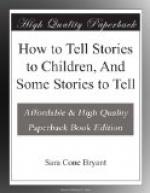And in the same way the people asked the little lame child, “What made you follow the music?” “I do not know what the others heard,” he said, “but I, when the Piper began to play, I heard a voice that told of a wonderful country hard by, where the bees had no stings and the horses had wings, and the trees bore wonderful fruits, where no one was tired or lame, and children played all day; and just as the beautiful country was but one step away—the mountain closed on my playmates, and I was left alone.”
That was all the people ever knew. The children never came back. All that was left of the Piper and the rats was just the big street that led to the river; so they called it the Street of the Pied Piper.
And that is the end of the story.
WHY THE EVERGREEN TREES KEEP THEIR LEAVES IN WINTER[1]
[Footnote 1: Adapted from Florence Holbrook’s A Book of Nature Myths. (Harrap & Co. 9d.)]
One day, a long, long time ago, it was very cold; winter was coming. And all the birds flew away to the warm south, to wait for the spring. But one little bird had a broken wing and could not fly. He did not know what to do. He looked all round, to see if there was any place where he could keep warm. And he saw the trees of the great forest.
“Perhaps the trees will keep me warm through the winter,” he said.
So he went to the edge of the forest, hopping and fluttering with his broken wing. The first tree he came to was a slim silver birch.
“Beautiful birch-tree,” he said, “will you let me live in your warm branches until the springtime comes?”
“Dear me!” said the birch-tree, “what a thing to ask! I have to take care of my own leaves through the winter; that is enough for me. Go away.”
The little bird hopped and fluttered with his broken wing until he came to the next tree. It was a great, big oak-tree.
“O big oak-tree,” said the little bird, “will you let me live in your warm branches until the springtime comes?”
“Dear me,” said the oak-tree, “what a thing to ask! If you stay in my branches all winter you will be eating my acorns. Go away.”
So the little bird hopped and fluttered with his broken wing till he came to the willow-tree by the edge of the brook.
“O beautiful willow-tree,” said the little bird, “will you let me live in your warm branches until the springtime comes?”
“No, indeed,” said the willow-tree; “I never speak to strangers. Go away.”
The poor little bird did not know where to go; but he hopped and fluttered along with his broken wing. Presently the spruce-tree saw him, and said, “Where are you going, little bird?”
“I do not know,” said the bird; “the trees will not let me live with them, and my wing is broken so that I cannot fly.”
“You may live on one of my branches,” said the spruce; “here is the warmest one of all.”




